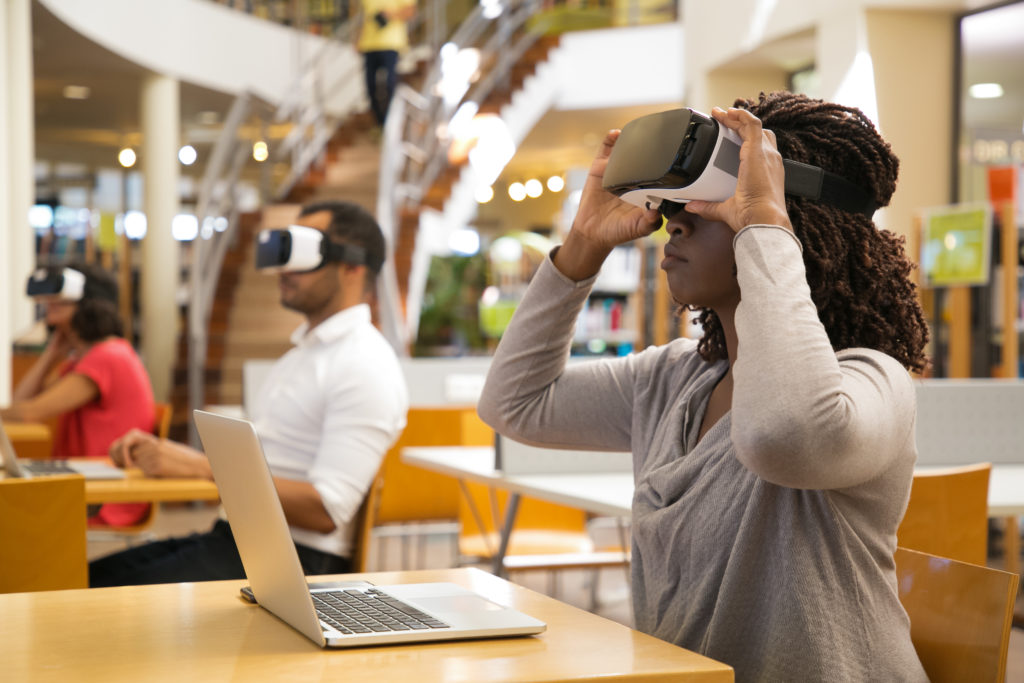Struggling to be heard in today’s noisy online world?
In 2024, businesses find themselves at a crossroads—a convergence of abundant opportunities and formidable challenges. The digital landscape is teeming with content, every brand vying for attention. Amidst this cacophony, understanding the target audience becomes paramount. It’s important to dive deep into their challenges, preferences, and buying behaviors. This is where data comes in. To truly thrive in this environment, we must harness the power of Generative AI (GenAI).
However, technological maturity remains a hurdle, and organizations strive to overcome it. As the data landscape shifts, it becomes evident which entities lag in this race for relevance.
Welcome to the era of strategic content marketing—where rising above the noise is both an art and a science!
The Power of Hyper-Targeted Content
Content that speaks directly to the individual is king. Niche Segmentation goes beyond traditional demographics, allowing you to create content that is tailor-made for specific interest groups. Hyper-targeting dives deep, considering behavior, interests, and intent, and packages them to help you create niche groups with unique needs.
Now that you know your audience, it’s time to speak directly to them. Personalization takes it a step further with the creation of dynamic and interactive content that aligns with individual user behavior and past decisions. Once you build a strong connection, this will lead to more engagement, better conversion rates, and stronger brand loyalty.
Utilizing research tools proves essential, particularly during the initial phases of establishing your online presence Some tools that you can experiment with are SparkToro, SEMRush, amd Ahrefs.
By leveraging hyper-targeted content, you’ll send the right message to the right person at the right time, by speaking directly to customers’ needs and aspiration, delivering a seamless and engaging experience.

AI-Driven Insights for Precision Marketing
Harnessing the power of Artificial Intelligence (AI) is no longer a choice, it’s a necessity. AI offers a treasure trove of data-driven insights that empowers marketers to deliver targeted campaigns with laser precision. Here’s how AI is revolutionizing precision marketing:
- Predictive Analytics: Leverage AI algorithms to predict user behavior, optimizing content distribution and timing for maximum engagement. Predictive analytics provide insights into what topics and types of content generate the most interest among your audience, enabling you to tailor your content strategy proactively. By anticipating the needs and preferences of your target audience, marketers can create a more personalized and compelling content strategy that not only captures attention but sustains it over time.
- Chatbots and Virtual Assistants: Enhance the user experience by integrating AI-driven chatbots and virtual assistants into your digital presence. These technologies serve as real-time, 24/7 channels for customer engagement and support, offering immediate responses to inquiries, guiding users through your content, and providing personalized recommendations based on their interactions. By incorporating chatbots and virtual assistants into their content marketing strategy, brands can foster a more interactive and accessible experience for users, thereby increasing engagement, satisfaction, and ultimately, conversion rates.
AI is not just a buzzword, it’s a game-changer in precision marketing. By leveraging its capabilities, marketers can gain a deeper understanding of their audience, personalize the customer journey, and achieve remarkable results.
Interactive Experiences
If you are a brand looking to stand out in the digital landscape, search no more. Interactive experiences are redefining how users engage with content.
- Interactive Infographics: Allow users to click on, hover over, or zoom into specific data points for more detailed information. By engaging users in this way, complex data becomes more digestible and engaging.
- 360° Product Tours: Revolutionize the online shopping experience by giving you a virtual, interactive experience—see products from every angle, zoom in for a closer look, and even catch them in action. It’s the ultimate shopping upgrade, helping you decide with a full view of the product.
Tools like ThingLink are glove-fit to encourage users to spend more time exploring the nuances of the information presented.
Start creating content that goes beyond static visuals, so your brand can capture and retain the attention of your targeted audience more effectively, offering them an engaging and memorable experience.

Voice Search Optimization (VSO)
We are in a Voice-First World! Did you know that 71% of consumers prefer using voice rather than typing when conducting queries? Optimizing your content for voice search, with an eye on featured snippets, can give you a significant advantage in this rapidly growing segment of search queries.
The shift to voice search is fueled by its convenience, letting users access information seamlessly without disrupting their tasks. Optimizing for voice search means grasping the natural language patterns users employ, opting for complete sentences or questions rather than the fragmented keywords in text searches.
In this voice-first world, content must align with smart speakers and virtual assistants. Adopt a conversational tone, structure content to directly answer potential questions, and incorporate long-tail keywords that mirror everyday conversation. This boosts the chances of your content being picked up in voice search results.
Voice Search Optimization (VSO) is crucial for a robust SEO plan. By grasping the nuances of voice search and applying effective VSO strategies, businesses can enhance visibility in voice search results, reaching a broader audience.
Getting a spot in featured snippets is vital for voice search optimization. Virtual assistants like Google Assistant, Siri, or Alexa often pull information from featured snippets. So, structure your content to directly answer questions, include FAQ sections, and provide clear, concise answers. By focusing on delivering value and direct responses in the first few sentences, you enhance your content’s chances of appearing in these coveted positions.
UGC Amplification
User-generated content (UGC) is a goldmine for brands seeking to build authentic connections with their audience. It’s the content your customers create – photos, videos, reviews – that showcase their real-life experiences with your brand. With approximately 30% higher conversion rates for campaigns that use UGC, you’ll definitely want to give it a try.
Here’s how to leverage UGC to transform customers into passionate advocates:
- Encourage Customer Storytelling: Run contests, encourage product reviews, and host social media challenges to incentivize customers to share their experiences. Ask open-ended questions that prompt them to showcase how your product or service enhances their lives.
- Shine a Spotlight on UGC: Don’t let great UGC go unnoticed! Share it on social media, product pages, and your website. Use customer photos in carousels, testimonials in blog posts, and user-generated videos in explainer sections. Show appreciation to customers for creating valuable content.
- The Power of Micro-Influencers: Partner with social media personalities with engaged, niche followings to create UGC that aligns with your brand. These individuals often hold more sway with their audience than traditional celebrities, fostering a sense of trust and authenticity.
Through a strategic UGC amplification strategy, you empower customers to become brand storytellers. Their authentic voices not only build trust and credibility but also inspire others to join the conversation and become loyal advocates for your brand.
Sustainability Storytelling
Sustainability storytelling is about incorporating these values into your brand’s story, which helps build trust and loyalty with eco-conscious customers.
One way to do this is by using eco-friendly messages throughout your marketing materials. For example, you can talk about using recycled materials in your packaging or product development, highlight the energy efficiency of your SaaS platform, or showcase how your products contribute to a circular economy.
Another important aspect is transparency. Customers want to know that your sustainability efforts are genuine. You can achieve this by being open about where your raw materials come from, how you package your products, and the labor practices in your supply chain.
Transparency can be shown through behind-the-scenes content like blog posts or videos, detailed product descriptions that explain their sustainability features, or engaging social media posts where you ask customers about their sustainability preferences.
By telling a story that emphasizes your commitment to environmental responsibility, you empower customers to make informed choices and position your brand as a leader in the sustainability movement

SEO Evolves: Beyond Keywords
The landscape of SEO is constantly shifting. While keywords are still important, search engines now focus more on understanding why users search. This means moving beyond simple keyword optimization to Semantic SEO.
Semantic SEO looks at the meaning behind searches, not just the keywords. It helps you understand what users want, like if they’re searching for a SaaS platform for project management or an email marketing tool. By understanding user intent, you can create content that meets their needs with related keywords and natural language.
Instead of stuffing in keywords, focus on creating quality content for humans. Make it easy to read, valuable, and naturally include relevant keywords. Structured data markup helps search engines understand your content better, improving visibility in search results.
Using Semantic SEO alongside structured data markup helps create user-friendly content that search engines understand easily. This is crucial for improving rankings and attracting more organic traffic in today’s SEO landscape.
Content Amplification: Beyond Social Media
While social media remains a powerful tool for content promotion, a comprehensive strategy goes beyond the likes and shares. Here’s how to leverage other channels to amplify your content and reach a wider audience:
- Reinvigorate Email Marketing: Segment your email list based on interests and preferences. Provide valuable content without constant self-promotion. Ensure emails are mobile-friendly for optimal engagement.
- Partner with Industry Publications: Identify relevant websites and craft compelling content aligned with their style. Build relationships with editors for ongoing collaborations.
- Explore Additional Channels: Engage in online communities, consider paid advertising, and build relationships with journalists for PR opportunities. Or you could sign-up for an Affiliate Network and let the work be done for you.
By implementing a multi-pronged content amplification strategy, you can break free from the confines of social media and reach a wider audience, fostering brand awareness and driving traffic back to your content hub.
Measuring Impact: Metrics That Matter
It’s time to look beyond vanity metrics and focus on the measures that are truly relevant. Success goes beyond vanity metrics like likes and shares. Sure, they provide a feel-good factor, but to gauge genuine impact, you need to delve deeper.
Focus on key aspects such as Conversion Rates to track actions taken on your website, CLTV to estimate long-term revenue, and Engagement Metrics to get a perfect picture of audience interaction with your content.
Remember that customers go through different stages on their journey from discovering your brand to purchasing. Attribution modeling helps identify which steps are most influential. Here’s how it works:
- Last Interaction Model: Credits the final touchpoint before a purchase, like clicking on an ad. It is simple but may overlook earlier influences.
- First Interaction Model: This model attributes the initial touchpoint, such as a social media post. It can be misleading if other touchpoints are more crucial later.
- Multi-Touch Attribution Models: These models spread credit across various touchpoints. They include linear attribution (equal credit) and time-decay attribution (more weight to recent interactions).
Analyzing attribution data reveals how your content impacts customer behavior. This helps optimize your content strategy for better results.

Conclusion
The digital arena in 2024 is not just crowded, it’s packed with opportunity. Understanding and implementing these refined content marketing strategies can position your brand at the forefront of this dynamic landscape. It’s about not just creating content but value, and in doing so, forging lasting connections with your audience. Keep evolving, stay relevant, and watch your content cut through the noise this year.





